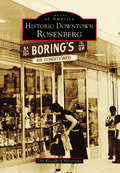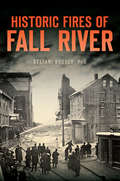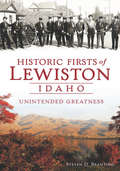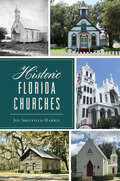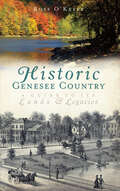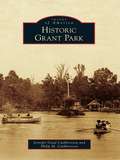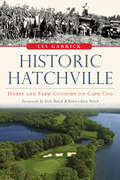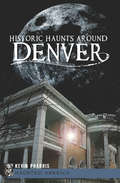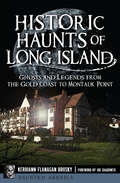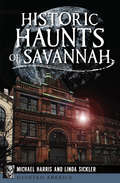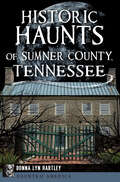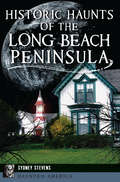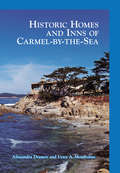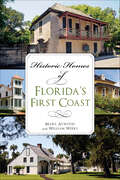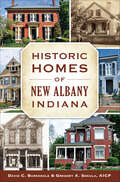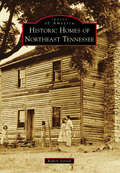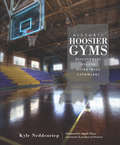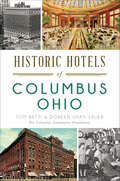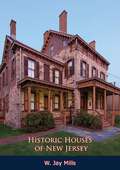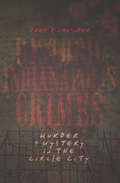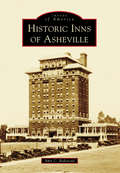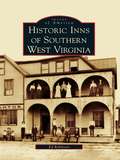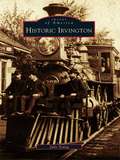- Table View
- List View
Historic Downtown Rosenberg
by The Rosenberg HistoriansRosenberg was created and thrived with the expansion of the railroad. From the first house in 1883, the city grew to become the "Hub of the Gulf Coast." Rosenberg was the center of commerce for settlers of all nationalities attracted here by fertile land and economic opportunity. In just 30 years, 56 businesses, including banks, loan and land development companies, merchants, doctors, and lawyers, were in the four-block area of the original Downtown Rosenberg Business District. Even celebrities came. For instance, outlaws Bonnie and Clyde ate their last meal at the Eagle Café in 1934. Also, actors John Wayne, Shirley Temple, and Roy Rogers could occasionally be found outside the Cole Theater, and while campaigning, Lyndon B. Johnson had his helicopter land on a downtown roof.
Historic Fires of Fall River (Disaster)
by Stefani KooreyFall River's textile boom in the nineteenth century brought with it a series of fiery disasters. The Big Fire of 1843 left more than one thousand people homeless and destroyed two hundred buildings, as well as twenty-some acres of land. After the Steiger Store Fire of 1916, mill owners pushed the city to replace horse-drawn brigades with fire engines. The intense heat from the Kerr Mill Thread Fire of 1987 melted hoses as first responders battled the blaze. Author Stefani Koorey chronicles the historic infernos of the Spindle City and celebrates the community's resilience in the face of adversity.
Historic Firsts of Lewiston, Idaho: Unintended Greatness
by Steven D. BrantingWhen a group of intrepid gold prospectors set up camp at the fork of the Snake and Clearwater Rivers in 1861, they expected to make camp for a night and move on. Instead, they made a town. It was an important--if unintended--accomplishment. And it was only the beginning of a long line of historic firsts for Lewiston, including the first capital, police department, newspaper and post office. Lewiston also boasted the state's first brewery and first vigilante association, both founded in the same year, appropriately enough. Join local historian and lifelong educator Steven D. Branting as he offers the first-ever chronology of unprecedented events, accolades and incidents that shaped Lewiston and Idaho from the city's founding to the present day.
Historic Florida Churches
by Joy Sheffield HarrisAuthor Joy Sheffield Harris guides readers on an architectural tour through the religious diversity of the Sunshine State . Over 200 years have passed since the first Florida church was established and today the Cathedral Basilica of St. Augustine has been restored to capture its original beauty. Pioneer Village Church at Shingle Creek is home to a replica of one the first churches built in the Kissimmee, the St. John's Episcopal Church. The former St. Paul's By-The-Sea is now the deconsecrated Beaches Chapel at The Beaches Museum and History Park in Jacksonville Beach. Travel throughout the state or enjoy the beauty of these and many more churches without leaving home.
Historic Fort York, 1793-1993
by Carl Benn Henry N.R. JackmanFearing an American invasion of Upper Canada, John Graves Simcoe had Fort York built in 1793 as an emergency defensive measure. That act became the first step in the founding of modern Toronto. Twenty years later, the Fort was the scene of the bloody Battle of York in which the famous American explorer, Zebulon Pike, died leading U.S. forces against the Fort’s outnumbered Canadian, British and Aboriginal defenders. The Americans won this battle – their first major victory in the War of 1812 – and torched the province’s public buildings during a six-day occupation. A year later, British forces retaliated by capturing Washington and burning its government buildings, including the White House. Rebuilt in time to drive off another American attack in 1814, Fort York was maintained through the 1880s to guard against internal unrest and potential American annexation. Even after its defences became obsolete, Fort York continued to serve as barracks and training grounds for the Toronto garrison until the 1930s, when it reopened as a historic site museum. In this book, Carl Benn explores the dramatic roles Fort York played in the frontier war of the 1790s, the birth of Toronto, the War of 1812, the Rebellion of 1837 and the defence of Canada during the American Civil War, and describes how Toronto’s most important heritage site came to be preserved as a tangible link to Canada’s turbulent military past.
Historic Genesee Country: A Guide to Its Lands and Legacies (History & Guide)
by Rose O'KeefeGenesee Country, composed of Allegany, Genesee, Wyoming, Livingston, Monroe and Ontario Counties near the Genesee River in western New York, is rich in local history with national importance. The Seneca and Algonkin nations once called this lush land home, and after the American Revolution, settlers came in hordes to till the soil and raise families. The region later became a hotbed of activity for abolitionists, early supporters of women's rights and religious movements that influenced the entire United States. In this book, author and local historian Rose O'Keefe chronicles the sites where these and other important events took place. Join her on a tour of Genesee Country's legacies.
Historic Grant Park (Images of America)
by Philip M. Cuthbertson Jennifer Goad CuthbertsonBoth the neighborhood of Grant Park and the 131-acre park take their shared name from railroad executive Lemuel P. Grant. The park was a gift to the City of Atlanta from Grant and was designed by John Charles Olmsted, the stepson of Frederick Law Olmsted. It became an urban haven where people came to "take the waters" from its natural springs, canoe on Lake Abana, and stroll the winding pathways in the pastoral park. A neighborhood sprang up around this oasis and was filled with homes that were designed in the spirit of Victorian painted ladies, Craftsman bungalows, Queen Anne, and New South cottages. In 1979, the structures within the neighborhood and park were placed on the National Register of Historic Places.
Historic Hatchville: Horse and Farm Country on Cape Cod (Brief History)
by Les GarrickThe village of Hatchville on Cape Cod boasts a rich history that began in 1740 with the first Hatch settler. Join author Les Garrick on a journey from the founding of Hatchville to the rise of the cranberry, poultry and dairy industries. Against all odds, the village has preserved this heritage, and today Hatchville remains horse and farm country. In 1915, Charles R. Crane purchased fourteen thousand acres of land, which his family turned into the Coonamessett Ranch Company, a model farm for locals that later turned into a resort. In 1986, dedicated individuals formed a land trust to preserve the remaining wildness of historic Hatchville, while local neighbors held the line against development. Uncover the stories of the land and the local heroes of historic Hatchville.
Historic Haunts Around Denver (Haunted America)
by Kevin PharrisThe author of The Haunted Heart of Denver goes beyond the city limits to investigate the supernatural surroundings of Colorado&’s capital. In Denver, the spirits aren&’t just penned to the city center. No, even the suburbs and outlying cities have the kind of history that could give quite a fright to the unsuspecting. Folks might be surprised to learn that a house in northwest Denver comes fully equipped with a basement theater—and spectral performers as well—and former phantom residents still roam their old homestead in what is now an Adams County open space. From Westminster&’s Bowles House Museum, where even the ghosts were involved in renovations, to Littleton&’s Melting Pot restaurant, a former Carnegie library that offers diners a side of the supernatural, accidental ghost hunter Kevin Pharris explores further tales of supernatural haunts and unexplained phenomena surrounding the Mile High City. Includes photos!
Historic Haunts of Long Island: Ghosts and Legends from the Gold Coast to Montauk Point (Haunted America)
by Kerriann Flanagan BroskyTake a ghostly journey through Long Island&’s history—photos included! Ghosts lurk at the Execution Rocks Lighthouse, where Revolutionary War Patriots were brutally tortured and killed by the British during the Battle of Long Island. Popular gathering places have otherworldly tenants, including Bayport&’s Grey Horse Tavern and the Cutchogue Village Green, where several old buildings—and their former inhabitants—are preserved. Long Island&’s history, dating all the way back to its Native American legends, is unearthed and preserved through its ghost stories and the spirits that have made their presence known. Through extensive research, interviews, and investigations, award-winning author and historian Kerriann Flanagan Brosky, alongside medium and paranormal investigator Joe Giaquinto, uncovers Long Island's eerie history.
Historic Haunts of Savannah (Haunted America)
by Michael Harris Linda SicklerGeorgia&’s oldest city plays hostess to a bevy of ghostly guests whose stories are wrapped up in its rich southern history. As one of America&’s most haunted cities, Savannah, Georgia, has a long list of stories of the supernatural, such as the story of the first two people hanged in colonial Savannah for the murder of their abusive master. Or James Stark, a tempestuous planter, and Dr. Philip Minis, who settled their dispute with a duel and still hang around the old building at Moon River Brewing Co. Or the terrifying &“boy-giant,&” Rene Rhondolia, who preys on young girls and animals. Join authors Michael Harris and Linda Sickler as they navigate the chilling world of those who refuse to leave their Savannah homes. Includes photos! &“Story-loving Sickler and research-savvy Harris dug behind the ghost stories of what&’s called one of America&’s most haunted cities.&” —Savannah Now
Historic Haunts of St. Louis (Haunted America)
by Jennifer ElwynSpirits of the Gateway City Since 1764, St. Louis has been the gateway to the unknown. Walk along the limestone cobbles of Laclede's Landing and witness the birth of a city with large aspirations and crooked dealings. Here you will find fur traders hardened by wilderness "law," former slaves fighting for their future, criminals immortalized in song, the rise and fall of the elite and the fight for the soul of a child. Meet the people behind Eads Bridge, the Old Courthouse, City Hospital, Lemp Brewery and more. From the Louisiana Purchase, the Civil War and Reconstruction to the modern day, hear their stories and learn why they may still haunt the cobblestones beneath your feet. Jennifer Elwyn delves into the dark side of a historic city.
Historic Haunts of Sumner County, Tennessee (Haunted America)
by Donna Lyn HartleyFrom the homes of the first settlers in Middle Tennessee to Gallatin's public square and everywhere in between, there is not a more haunted county in America. The Winchesters' unique and architecturally impressive Cragfont had mysterious occurrences from its very beginnings in the late 1700s. Gallatin's public square, its courthouse, loft apartments and places of business have hauntings that seem to specifically point to restless spirits still unsettled from the oppressive days of Civil War occupation by a brutal commanding officer of the Union army. Even the modern subdivisions are not immune to the supernatural, hosting everything from flying cryptids to tormented spirit-remnants of the bloody conflict between settlers and Native Americans. Author Donna Lyn Hartley details the spooky side of Sumner County.
Historic Haunts of the Long Beach Peninsula (Haunted America)
by Sydney StevensThe towns and scenic byways of the Long Beach Peninsula attract more than just tourists, and from Oysterville to Ilwaco, ghostly tales abound. In Seaview, the Lamplighter hosts a multitude of spirits, including Lily, a murdered barmaid, while at the nearby Shelburne Inn, many guests have reported a ghostly presence that has yet to be identified. Mysterious footsteps can be heard on the stairs of the George Johnson house in Ocean Park, and a man holding a baby is rumored to appear at the Old Ilwaco Hospital. Join author and historian Sydney Stevens as she uncovers the spooky side of these beloved seaside towns.
Historic Homes and Inns of Carmel-by-the-Sea
by Alissandra Dramov Lynn A. MomboisseHistoric Homes and Inns of Carmel-by-the-Sea showcases the creativity, talent, and originality of the town's residents, designers, and builders over a span of 80 years, from the pioneering days of the 1880s through the more contemporary ones of the 1960s. One-of-a-kind creations by top-name architects Frank Lloyd Wright, Julia Morgan, Charles Greene, Albert Farr, Gardner Dailey, Henry Hill, and Mark Mills are featured. The designs by the three most influential people who shaped Carmel-by-the-Sea architecturally in its first half-century are well-represented: M.J. Murphy, who literally built the town, with hundreds of homes and buildings to his credit; Hugh Comstock, who defined it with his storybook cottages that gave the village its fairy-tale charm; and Jon Konigshofer, who modernized it through his trademarked, postwar Hillside House. Throughout its history, Carmel-by-the-Sea, California, has attracted unique, spirited, and sometimes eclectic individuals, and this is reflected in its architecture. In combination with the breathtaking beauty, remarkable scenery, and coastal setting, these historic homes and inns give the village its distinct look and make it unlike any place else.
Historic Homes of Florida's First Coast (Landmarks)
by Mary AtwoodSome of the earliest European settlers colonized Northeast Florida when it was little more than a wilderness. Today, the area is rich in multicultural heritage and historic significance, and its historic homes stand as a testament to its intriguing past. Step inside a Second Spanish Period structure that was home to European royalty and visited by iconic film star Greta Garbo. Visit the places that inspired works such as Marjorie Kinnan Rawlings's Pulitzer prize-winning novel "The Yearling" and British composer Frederick Delius's masterpiece, "Florida Suite." Author and award-winning photographer Mary Atwood explores the homes of early colonial settlers, wealthy plantation owners, illustrious Florida artists and those responsible for shaping Florida's First Coast.
Historic Homes of New Albany, Indiana (Landmarks Ser.)
by David C. BarksdaleNew Albany's historic homes boast unique histories and fascinating stories of those who inhabited them. Founded in 1813 below the falls of the Ohio River, the city was Indiana's most populous by the middle of the nineteenth century. Many leading citizens built grand mansions and family dwellings that beamed with prosperity and influence. The architectural legacy during these formative years continued into the early twentieth century and produced historic neighborhoods with a rich collection of housing styles. Join authors David C. Barksdale and Gregory A. Sekula as they delve into the history of New Albany's most cherished old homes.
Historic Homes of Northeast Tennessee (Images of America)
by Robert SorrellThe communities of northeast Tennessee are among the oldest settlements west of the Appalachian Mountains and the original 13 colonies. The cities of Bristol, Johnson City, and Kingsport and surrounding towns of Elizabethton, Erwin, Greeneville, Jonesborough, Mountain City, and Rogersville are home to some of the most remarkable historic houses in the country. The region is home to the oldest frame structure in Tennessee--the Carter Mansion in Elizabethton--and Pres. Andrew Johnson's residences in Greeneville, the Rocky Mount State Historic Site in Piney Flats, the Allandale Mansion in Kingsport, and the Roderick Butler Mansion in Mountain City. Northeast Tennessee features mountain log cabins, brick Federal-style residences, Georgian, Colonial, and Victorian mansions, urban apartment dwellings, row houses, and a number of other architectural styles. The region's oldest homes were built in the late 1700s, including the Gillespie stone house in Limestone.
Historic Hoosier Gyms: Discovering Bygone Basketball Landmarks
by Kyle NeddenriepKick snow from your shoes and step into the warmth of the old Hoosier high school basketball gym, where farmers in overalls line the court and students heckle referees from planks above the bleachers. Revisit a unique era when nearly every town had a high school and its own basketball team. The gyms featured here no longer host high school games, but once they were home to the Ladoga Canners, the Mecca Arabs, the Roll Red Rollers, the Arlington Purple Breezes, the Warren Lightning Five and dozens more. Now they are elementary schools, community centers, fire stations, churches. Some are homes. Sadly, others are wasting away. But once again, the ball thuds in these gyms. The screams reverberate. The whistles blow. Join the Indianapolis Star's Kyle Neddenriep on this tour of one hundred former Hoosier high school basketball gyms.
Historic Hotels of Columbus, Ohio (Landmarks)
by Tom BettiThough only a handful remain today, the Capital City once boasted a wealth of illustrious hotels and raucous two-bit establishments. Grande dame hotels like the Neil House, the Great Southern, the Hartman, the Chittenden and the Deshler achieved the height of elegance and refinement. More modest establishments were frequented by fugitive Confederate generals, notorious bootleggers and Fidel Castro's family. Join the Gilded Age bachelors who decked out banquet halls to look like camping sites and the Hungarian revolutionaries who failed to keep a low profile. From devastating hotel fires to ornate outhouse fittings, authors Tom Betti and Doreen Uhas Sauer introduce you to a whole new side of Columbus history.
Historic Houses of New Jersey: [Illustrated Edition]
by W. Jay MillsOne of the standard works on notable early houses in the state.“UNTIL now the State possessing the most inexhaustible supply of colonial, Revolutionary, and republican souvenirs has been almost neglected. Indeed, few of the original thirteen States can be compared with New Jersey in the number and importance of its landmarks. Her society, too, was as intellectual as that which sprang from the rocks of Puritanism, and it formed a brilliant pageant, rivalling the glittering line of the cavaliers. There is scarcely an acre of soil in the northern part of the State not once pressed by the foot of the Revolutionary soldier, and there are few of the many hundreds of dwellings which have survived the march of a century that did not shelter at one time or another some of the heroes of ‘76, or the colonial dames and daughters who played scarcely less potent parts in the drama of our struggle for freedom. This is the only book to tell the true story of the old houses of New Jersey, and such a record possesses deep significance for every American, as it has much more than a local or State interest.Of the glowing and passionate pictures of early days little more than the frames and the sentiment lingering about them now remain. It has been the author’s pleasure to fill in the frames with the portraits and the scenes that history and tradition, as contained in family recollection, in unpublished letters, and in local records suggest. Anecdote and gossip have supplied him with many a side-light on the great figures and their stirring times, and their chronicler will be satisfied if his story shall make more real the facts with which fancy delights to play.”
Historic Indianapolis Crimes: Murder & Mystery in the Circle City (Murder And Mayhem Ser.)
by Fred D. CavinderFrom the 1954 &“Dresser Drawer Murder&” to the mass killing of seven people in 2006, the author of Forgotten Hoosiers chronicles Indianapolis&’s dark history. Hear tales from the Circle City&’s murderous underbelly, from poor Silvia Likens, who was tortured for months by her foster mother and eventually discovered dead, to Carrie Selvage, whose skeleton was found in an attic twenty years after she disappeared from a hospital bed in 1900. Discover how housekeepers found Dorothy Poore stuffed in a dresser drawer on a July day in 1954 and the curious story of Marjorie Jackson, her body was discovered clothed in pajama bottoms and a flannel robe on her kitchen floor, and police found $5 million hidden around her house in garbage cans, drawers, closets, toolboxes and a vacuum cleaner bag. Join local historian Fred Cavinder as he recounts the gruesome tales of Indiana&’s capital city, from mystery to murder. Includes photos!
Historic Inns of Asheville
by Amy C. RidenourFor two centuries, people have traveled through the mountains of North Carolina to the city of Asheville. Early visitors came on foot, driving animals to market down the Buncombe Turnpike. Later, stagecoaches brought wealthy planters out of the heat of low-country summers. The railway brought an influx of visitors from all over the country, including Northerners escaping cold winters and patients looking for health cures. The advent of the automobile made travel even more accessible, and people flocked to the mountain town for scenery and entertainment. Tourism became central to Asheville's growth and industry, with many of the towns' prominent citizens taking part in the hotel trade and building iconic hotels like Battery Park and Grove Park Inn that attracted famous guests from all over the world. From simple hotels to large grand inns, economical boardinghouses, and accessible motels, Historic Inns of Asheville showcases the city's abundant history of accommodation.
Historic Inns of Southern West Virginia
by Ed RobinsonSouthern West Virginia possesses great natural beauty and a rich history in which lodging has played a significant role. This book traces the evolution of lodging in the area from the late 1700s to the present. The various types of accommodations included log cabins; lodging in rail, coal, and lumber communities; picturesque stagecoach stops; state parks; bed-and-breakfasts; and opulent mineral springs hotels. During the Civil War, many of the springs hotels and stagecoach stops were used for army hospitals and headquarters. This volume provides glimpses of quaint towns such as Bramwell, Fayetteville, Union, and Lewisburg, as well as the more commercial towns of Princeton, Bluefield, Hinton, Beckley, Glen Jean, Gary, Cass, Ronceverte, Marlinton, Coalwood, Rainelle, and Glen Rogers.
Historic Irvington (Images of America)
by Julie YoungFounded in 1870, historic Irvington serves as a time capsule to the bygone days of the Victorian and Edwardian eras. The once autonomous community along the Pennsylvania Railroad and U.S. Route 40 has a history as rich and spellbinding as the legendary tales of its namesake, Washington Irving. Featuring plenty of architectural diversity and notable citizens, Irvington served as the original home to Butler University and became known as a cultural, arts, and academic pillar of the Indianapolis landscape. Today Irvington continues to be the gem of Indianapolis's east side with locally owned shops and businesses along with a community that is committed to the past while focusing on the future.
